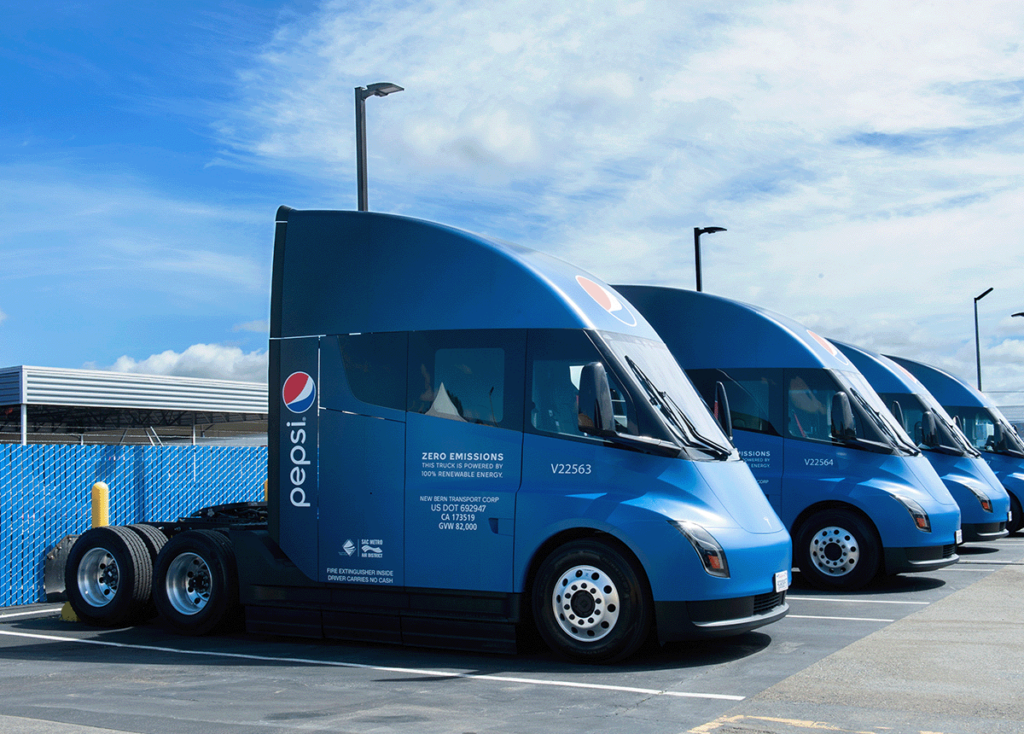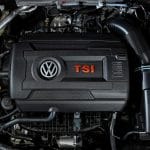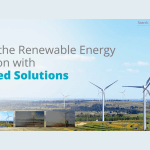PepsiCo Beverage’s Electric Fleet Is Driving Progress Toward Net Zero Emissions Goal

PepsiCo’s fleet and electric infrastructure, including Tesla Semi trucks, spotlighted to push the industry forward in building electric depots
PepsiCo Beverages North America’s (PBNA) Sacramento-based Tesla Semi trucks are taking part in the North American Council for Freight Efficiency’s (NACFE) national “Run on Less: Electric Depot” trucking event this September.
In December 2022, PepsiCo took the first delivery of the all-electric Tesla Semi trucks and as of September 1, nearly 680,000 Zero Emissions (ZE) miles have been traveled.
PBNA’s Sacramento, Calif. bottling production and distribution facility is using a variety of electric vehicles including BYD Electric yard tractors, light-duty Ford E-Transit Service vehicles and 21 Tesla Semis as the company is working toward its ambitious pep+ (PepsiCo Positive) goal of net zero emissions by 2040. The Tesla Semis being deployed out of Sacramento run two different types of routes: long-haul routes that transport between 250 and 520 miles per run and with a gross vehicle weight plus load of up to 82,000 lbs.; And 18 different delivery routes where the trucks cover less than 75 miles per day, hauling a diminishing load that leaves nearly full and lightens throughout the day as deliveries are made.
The three Tesla Semis participating in the Run on Less are driving slip-seated long-haul transport routes. After two weeks (Sept. 11 – Sept. 23), these Semis have accumulated a total of 19,122 miles. Approximately 65 percent of miles driven during the first two weeks of Run on Less were loaded to a gross vehicle weight plus load of over 70,000 pounds. The program has also demonstrated the capability of megawatt charging in transport operations enabling slip-seat, continuous transportation capabilities with an electric vehicle.
“In PepsiCo’s journey to net zero emissions by 2040, we are constantly looking to scale our impact beyond our own operations,” said Todd Squarek, Senior Vice President, Chief Sustainability Officer for PepsiCo Beverages North America. “As we electrify our fleet to reduce our emissions, we’ve captured insights around infrastructure, charging, training and partnerships that we are excited to share along with metrics captured in the Run on Less challenge.”
Preparing for the deployment of the Tesla Semis included installation of four 750-kilowatt Tesla chargers for a total of 3 megawatts of installed charging capacity at a time at the Sacramento facility. The chargers are supplemented with the Telsa Megapack Battery Energy Storage System. PepsiCo worked closely with the Sacramento Municipal Utility District to ensure the 24-hour a day fleet’s operational needs could be met.
Related Article: The PepsiCo Foundation to host Black Restaurant Accelerator Program
Some of the progress in expanding PBNA’s electric fleet was made possible by a grant provided by the California Air Resources board as part of their California Climate Investments initiative.
This year’s NACFE Run on Less program is focused on sharing learnings from industry leaders to scale electric trucks across a variety of market segments, helping to showcase what it takes to move from one or two electric vehicles to 15 or more. The event features ten fleet depots that encompass 15 or more Class 3 to Class 8 battery electric vehicles operating in the U.S., Canada or Mexico.
PBNA Sacramento-based Transport Driver Casey Thijon has been driving for 25 years and volunteered to be among the first to drive the Tesla Semi. “People are sometimes still surprised to see a woman driving a Semi, imagine their surprise when it’s a Tesla Semi!” said Thijon. “When I started driving the Tesla Semi on my regular business routes, I was getting questions about if it really was working off a charge, how much it could haul and how it felt to drive. Some people thought it was all too good to be true. But, it’s been fun to say it’s all electric, can haul our regular shipments of beverages and feels great to drive.”
Frito-Lay North America’s Queens, New York, facility is also participating in Run on Less. Home to one of Frito-Lay’s fastest fleet and charging infrastructure transformations, the Queens facility aims to have a fully-electric fleet of more than 60 Ford E-Transits by the end of 2023. Throughout the event, Frito-Lay will provide learnings and metrics from two of these E-Transits, with a focus on operating in urban delivery.
The data gathered from all the Electric Depots will be used to provide insights and guidance to tackle the challenges that come with electrifying a fleet, including building a charging network and its supporting infrastructure, along with building grid capability and resilience. The findings aim to equip corporations with data to build plans, leverage new technology and manage collaboration with local utilities to ensure the necessary power capacity and other capabilities for electrification are supported, and that companies can effectively expand their electric depot.
As PepsiCo looks to build out the partnerships and infrastructure to further electrify its fleet, the organization is also looking at off-site charging. PepsiCo recently struck a three-year deal with TeraWatt Infrastructure, a company powering electrified fleets with a full spectrum of electric vehicle charging solutions. The deal will see PepsiCo’s vehicles utilizing TeraWatt’s multi-tenant site in Rancho Dominguez, Calif. The site provides high-powered charging infrastructure along with software, operations, and maintenance services.








